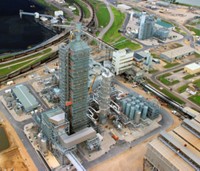Advertisement
Grab your lab coat. Let's get started
Welcome!
Welcome!
Create an account below to get 6 C&EN articles per month, receive newsletters and more - all free.
It seems this is your first time logging in online. Please enter the following information to continue.
As an ACS member you automatically get access to this site. All we need is few more details to create your reading experience.
Not you? Sign in with a different account.
Not you? Sign in with a different account.
ERROR 1
ERROR 1
ERROR 2
ERROR 2
ERROR 2
ERROR 2
ERROR 2
Password and Confirm password must match.
If you have an ACS member number, please enter it here so we can link this account to your membership. (optional)
ERROR 2
ACS values your privacy. By submitting your information, you are gaining access to C&EN and subscribing to our weekly newsletter. We use the information you provide to make your reading experience better, and we will never sell your data to third party members.
Environment
Cheap, Abundant Shale Gas Won’t Significantly Cut U.S. Greenhouse Gas Emissions
Energy: New study looks at the contested effects of increased shale gas production on the release of greenhouse gases
by Janet Pelley
May 2, 2014

The rapid expansion of shale gas production in the U.S. has triggered a polarizing debate: Environmentalists charge that methane leaks could make shale gas a higher carbon emitter than coal, while some industry experts and the Obama Administration claim that cheap shale gas will help cut emissions, even in the absence of policies that constrain carbon release. A new study aiming to settle that debate finds that abundant shale gas by itself will neither slow nor accelerate the current rate of U.S. greenhouse gas emissions (Environ. Sci. Technol. 2014, DOI: 10.1021/es4046154).
Hydraulic fracturing—a technology that uses pressurized water to release natural gas out of tight shale rock formations—has boosted shale gas from less than 1% of U.S. natural gas production in 2000 to 34% in 2012. Earlier studies on the effects of this production jump have either done so by comparing emissions from shale gas to those from other fuels or predicting the impacts of a flood of shale gas on energy markets. Last year, Richard G. Newell and Daniel Raimi, energy economists at Duke University, decided to do both.
The researchers had to consider a range of intertwining issues that ultimately determine how shale gas will affect U.S. greenhouse gas emissions. For example, at power plants, burning natural gas emits half the amount of greenhouse gases as coal does. But, during production and distribution, methane leaks could negate these benefits. To complicate things further, there is some uncertainty about the magnitude of these leaks.
Besides the emissions directly associated with shale gas, the energy source’s net impact on emissions depends on the kinds of fuel it displaces. Switching to natural gas from high-carbon coal could slow emissions, but displacing more expensive zero-carbon renewables could increase them. Meanwhile, if more shale gas leads to lower energy prices overall, consumers might ramp up consumption, negating any potential cuts in emissions.
In the researcher’s analysis, they examined whether fuel switching is more important than increased consumption by turning to the U.S. Energy Information Administration’s national energy model. The model projects how changes in the supply and prices of each fuel affect decisions about which energy sources companies invest in and how much energy the U.S. consumes. They ran the model from 2010 to 2040, comparing a baseline scenario using current policies and production levels with a hypothetical scenario in which shale gas dominates natural gas production. Next, they coupled the model’s results to Environmental Protection Agency data on lifecycle greenhouse emissions from gas, coal, oil, nuclear power, and renewables. Newell and Raimi accounted for uncertainty about methane leakage by employing a range of low- to high-leakage estimates.
The analysis suggests that by 2040, cheap, abundant shale gas will displace more coal than renewables and nuclear power for electricity, cutting emissions from electricity-generation by 5.1%. However, energy use in general will rise, causing total U.S. greenhouse gas emissions to drop by only 0.3% from the baseline scenario. High methane emissions could inflate total emissions by a modest several tenths of a percent.
“Natural gas abundance alone has no impact on greenhouse gases,” Newell says. But he points out that models from other researchers have shown that natural gas could be used as a bridge fuel as the U.S. moves away from coal to low-carbon energy sources when paired with polices that put a price on carbon release.
“If we had a carbon policy in place, economic forces would be operating in concert to back out of carbon-intensive sources of energy and to reduce the total amount of energy used, thereby reducing greenhouse gas emissions,” says Hillard Huntington, an energy economist at Stanford University. He cautions that although the Duke study is important, there are large uncertainties in energy markets and that expansion of hydraulic fracturing to Asia or increased coal exports from the U.S. could change the supplies and prices included in the team’s model.



Join the conversation
Contact the reporter
Submit a Letter to the Editor for publication
Engage with us on Twitter